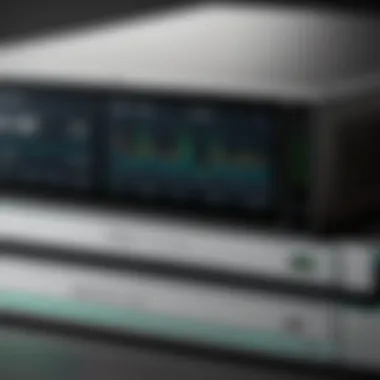Meraki vs Cisco: In-Depth Networking Solution Comparison


Intro
In the realm of networking technologies, choosing the right solution can determine the efficiency and security of an organization’s operations. With numerous options available, two names often come up for consideration: Meraki and Cisco. Both offer a wide array of products tailored to different needs. This examination aims to compare these two giants, focusing on their respective features, strengths, weaknesses, and suitability for diverse user scenarios.
Understanding the nuances between these solutions helps professionals navigate the intricate landscape of modern networking. Whether for small businesses or large enterprises, some aspects will resonate particularly well. This comparison will break down vital elements that can influence a decision-making process.
Overview of Software
Purpose and Use Cases
Meraki offers a cloud-managed approach, streamlining deployment and management substantially. It caters to users who prefer a simplified interface to manage their network devices. Organizations focusing on ease of use typically gravitate towards Meraki, especially small to medium-sized enterprises seeking efficiency without significant overhead.
Cisco, meanwhile, is more traditional and adaptable, boasting powerful customization features. Ideal for larger enterprises with complex networking needs, Cisco solutions are often preferred in scenarios demanding deep integration and robust capabilities. It supports various environments, ranging from small offices to expansive data centers.
Key Features
Meraki provides several notable features:
- Cloud-based Management: Users can access and manage networks remotely, which simplifies operations and enhances efficiency.
- Dashboard Interface: A user-friendly dashboard that minimizes the learning curve for new users.
- Built-in Security: Advanced security protocols are integrated by default, decreasing the chances of vulnerabilities.
On the other hand, Cisco stands out with features such as:
- Customization: Highly customizable solutions that allow tailored configurations for each organization’s needs.
- Extensive Product Lineup: A wide range of products, including routers, switches, and access points, ensures scalability.
- Robust Security Options: Cisco frequently updates its security protocols, providing a high level of data integrity and protection.
In-Depth Review
Performance Analysis
Performance metrics vastly differentiate Meraki from Cisco. Meraki, being cloud-managed, often shows strong performance in basic operations and deployments. Its ease of updates contributes to a consistent user experience. However, potential performance dips can occur during high-load scenarios due to reliance on stable internet connections.
Cisco excels in performance under high capacity. Their hardware solutions can handle substantial loads and offer flexibility in configurations that may enhance throughput. It is suitable for environments where uptime and performance consistency are critical. The overall results from benchmarking indicate that for high-demand use, Cisco may be the preferred choice.
User Interface and Experience
The user interface of Meraki is one of its most praised features, providing a clean and intuitive experience. Users find it easy to navigate, contributing to efficient network management.
Conversely, while Cisco also offers a user interface, it demands a steeper learning curve. Network professionals with expertise usually find it aligns better with their needs. Still, for those less familiar with IT environments, it can appear daunting.
"Selecting the right networking solution depends on the specific requirements of the organization, including its size, complexity, and existing infrastructure."
Prelims
The choice between Meraki and Cisco represents a crucial decision for organizations seeking effective networking solutions. Understanding the differences and similarities between these two companies can significantly affect the operational success of IT systems.
The dynamics of network management impact not just performance but also user experience, security, and overall cost. Consequently, decision-makers are tasked with evaluating both options against their specific requirements. This comparison aims to provide a nuanced insight into how each solution can align with various organizational needs, whether for a small business or a large enterprise.
Meraki specializes in cloud-based networking, focusing on simplicity and user-friendliness. On the other hand, Cisco has a more traditional approach, offering depth and customization in its solutions. Both have distinct advantages, but the relevance of their offerings hinges on the context of the user. Thus, exploring these nuances is essential for informed decision-making.
This exploration helps discerning readers navigate the complexities of modern networking technologies.
As we delve into the specifics of each solution, we will highlight the key features, pricing structures, and user experiences to paint a complete picture of what each brand represents in the world of networking.
Understanding Meraki
Understanding Meraki is crucial for readers seeking a clear differentiation in the landscape of networking solutions. As a branch of Cisco Systems, Meraki emphasizes cloud-based technology, allowing for management of networking resources remotely. Its innovative architecture offers various benefits, such as ease of deployment, robust analytics, and simplified ongoing management. This section will delve into critical components like company history, core features, deployment options, and the target audience.
Company Background and History
Meraki was founded in 2006 by Sanjit Biswas, John Bicket, and Hans Robertson. Initially, the company aimed to provide easy-to-deploy wireless networking solutions for businesses. The name "Meraki" comes from a Greek word that means to do something with soul, creativity, or love. In 2012, Meraki was acquired by Cisco Systems, marking its integration into a larger ecosystem of networking solutions. This partnership has enabled Meraki to leverage Cisco's vast resources and expertise, enhancing its offerings significantly.
Key Features of Meraki
Meraki is recognized for its distinctive features that provide users with a streamlined experience. Some key features include:


- Cloud Management: This allows organizations to manage their entire network from anywhere, increasing operational efficiency.
- User-Friendly Interface: The Meraki dashboard is intuitive, making it easy for both technical and non-technical users to navigate.
- Real-Time Analytics: Provides insights into network performance, user behavior, and device status, facilitating quick decision-making.
- Seamless Updates: Users benefit from automatic updates without downtime, ensuring systems are always up to date.
Deployment Options
Meraki provides flexible choices for deploying its technologies, catering to various business needs. This adaptability is essential for organizations of different sizes and industries.
Cloud-Based Management
Cloud-Based Management is a hallmark of Meraki's service. This deployment method reduces the need for extensive on-site hardware, allowing companies to manage their networks remotely. One key characteristic of Cloud-Based Management is its centralization. All data and configurations are stored in the cloud, simplifying access and oversight.
The benefits include:
- Instant access to network information from anywhere.
- Scalability to accommodate business growth without significant hardware investments.
- Reduced IT maintenance costs and manpower.
Nonetheless, the potential downsides include reliance on internet connectivity. An unstable connection can impact access to the dashboard, resulting in slower response times.
On-Premise Solutions
While Meraki is known for its cloud capabilities, On-Premise Solutions still hold value for businesses requiring localized control. This option allows organizations to retain sensitive data internally, ensuring compliance with specific regulations.
A significant advantage is the increased security associated with keeping data within an organization's premises. Businesses operating in regulated industries may find this option necessary. However, it comes with challenges such as higher upfront costs and ongoing maintenance requirements since IT teams must manage hardware and software locally.
Use Cases and Target Audience
Meraki appeals to a broad spectrum of users, ranging from small startups to large corporations. The target audience includes IT administrators looking for straightforward networking solutions and organizations that want to reduce the burden of network management. Specific examples include:
- Educational Institutions: Meraki’s easy-to-manage systems are ideal for schools seeking to improve connectivity across campuses.
- Retail Chains: Businesses can use Meraki to provide customer Wi-Fi and manage point-of-sale systems efficiently.
- Healthcare Facilities: Secure and reliable networks are essential in hospitals, where Meraki offers both performance and compliance with strict data privacy standards.
Through its combination of innovative features and deployment flexibility, understanding Meraki provides valuable insight into its fit within the broader context of networking solutions.
Exploring Cisco
In any comparison of networking solutions, it is critical to explore the key players in the field. Cisco stands as one of the most established names in the industry. Understanding Cisco offers insights into its comprehensive solutions and how they can effectively meet the diverse needs of organizations. Cisco's offerings are extensive. They provide networking hardware, software, and services that have set many standards in the field. This section illustrates its foundation, essential features, and adaptability through various deployment methods, underscoring its appeal for different user profiles.
Company History and Evolution
Cisco Systems was founded in 1984 by Leonard Bosack and Sandy Lerner. The company quickly became known for its innovations in network technology. Over the years, it expanded its range of products significantly, acquiring various companies along the way. This growth positioned Cisco not only as a hardware provider but also as a software solutions architect. Today, it is a leader in the global networking market, providing advanced solutions that cater to evolving technology needs.
Core Features of Cisco Solutions
Cisco offers an array of core features that distinguish its solutions. Some of the more notable features include:
- Robust Security Measures: Cisco products come with integrated security functions. This ensures protection against threats and vulnerabilities.
- Scalability: Their solutions cater to businesses of all sizes, adjusting to growing demands efficiently.
- Unified Management Tools: Cisco provides tools that facilitate the centralized management of networking components. This promotes operational efficiency.
With these features, organizations can rely on Cisco for their extensive networking and security needs.
Deployment Flexibility
Cisco's deployment flexibility allows organizations to choose based on their requirements. Two primary methods present distinct advantages:
On-Premise Infrastructure
On-Premise Infrastructure is favored by many organizations due to its control. This deployment method allows organizations to manage their network directly, ensuring data security and compliance with industry regulations. A key characteristic of on-premise solutions is the high degree of customization. While initial setup costs are comparatively higher, ongoing costs may stabilize over time.
Advantages of On-Premise Infrastructure include:
- Full Control Over Data: Organizations have direct access to their data, enhancing security.
- Customization Options: Tailoring features to meet specific requirements becomes easier.
- Reduced Latency: Local management often leads to quicker response times.
However, the on-premise approach does require ongoing maintenance and technical expertise.
Cloud Deployments
Cloud Deployments represent a modern trend in networking solutions, with many organizations opting for this model due to its flexibility and cost-effectiveness. This method allows businesses to access networking resources as needed, rather than investing heavily in infrastructure. A unique aspect of cloud deployments is their ability to scale resources up or down quickly.
Key advantages of Cloud Deployments include:
- Cost-Effective Scaling: Organizations pay only for resources they use.
- Accessibility: Remote access facilitates collaboration across distributed teams.
- Reduced Maintenance Needs: Service providers handle the infrastructure, allowing organizations to focus on core business functions.


Nonetheless, reliance on external providers raises some concerns about security and data control.
Typical Users and Applications
Understanding typical users and applications of Cisco solutions demonstrates their versatility. Cisco serves a wide range of industries, including education, healthcare, finance, and government agencies. Each sector has unique requirements that Cisco addresses effectively.
Organizations looking to enhance security while optimizing their network infrastructure will find Cisco's offerings particularly suitable. Businesses focused on scalability and robust performance must evaluate how these solutions align with their goals.
"Cisco's evolution from hardware provider to comprehensive solutions architect demonstrates its adaptability and relevance in a fast-changing technology landscape."
Feature Comparison
The comparison of features between Meraki and Cisco is a crucial point in understanding their offerings. By evaluating various functionalities, users can identify strengths and weaknesses of each solution. This section highlights essential elements such as management interfaces, performance metrics, security features, and support documentation. Knowing these details aids decision-makers in selecting the right networking solution suited to their unique needs.
Management Interface
User Experience
In terms of user experience, Meraki's interface is designed with simplicity in mind. Users appreciate its clean layout and intuitive controls. This contributes significantly to the overall goal of effective network management. One of the key characteristics of Meraki’s user experience is the easy navigation through features. This makes it a popular choice, especially for those who may not have extensive technical expertise. A unique feature includes a graphical dashboard that provides real-time insights. This can enhance operating efficiency, but some users may find it limiting for advanced configurations.
Ease of Use
When discussing ease of use, Meraki stands out by providing a cloud-based solution that simplifies setup and management. This characteristic is beneficial for teams needing to deploy networks quickly without deep technical knowledge. One unique aspect of ease of use is the step-by-step wizards that guide users through common tasks. While this can speed up deployment, advanced users might find it cumbersome as it offers less flexibility.
Performance Metrics
Speed and Efficiency
Speed and efficiency are paramount when comparing networking solutions. Cisco is widely recognized for its robust hardware, which often results in superior performance. The high throughput capabilities make Cisco a favorable option for large enterprises. A defining feature is the ability to handle heavy traffic while maintaining speed. However, this performance can come at a higher cost in terms of both initial investment and ongoing maintenance.
Scalability Options
Scalability is another crucial element in this comparison. Meraki’s architecture allows for quick scaling of resources, which is ideal for growing businesses. Users often find the cloud-model approach seamless when adding devices. This characteristic makes it beneficial for smaller organizations with fluctuating needs. Nonetheless, while scalability is straightforward, large-scale implementations might require careful planning to prevent bottlenecks in performance.
Security Features
Threat Detection
Threat detection is a vital aspect of network management. Cisco has a longstanding reputation for providing comprehensive threat detection capabilities. This includes advanced analytics and machine learning to identify unusual network behavior. Its key characteristic is the proactive response to potential threats. This sophistication makes Cisco a strong contender in environments sensitive to security. However, the complexity may pose a learning curve for new users.
Data Protection
Data protection remains a high priority in today's digital landscape. Meraki offers built-in features such as data encryption and access controls. Users find these essential for safeguarding information. The significant advantage of Meraki's approach is the user-friendly implementation of these security features. However, companies with strict compliance requirements might find Meraki’s options less customizable than Cisco's offerings.
Support and Documentation
In this digital age, having robust support and documentation is crucial. Meraki provides accessible online resources, including tutorials and community forums. This availability helps users troubleshoot issues effectively. However, some users find the depth of documentation lacking for advanced features. In contrast, Cisco offers extensive documentation and a dedicated support network. Though it may be more complex to navigate, users often appreciate its thoroughness. This can be advantageous for enterprises requiring detailed guidance on intricate configurations.
Pricing Structures
Understanding the pricing structures of networking solutions is essential for organizations aiming to make informed choices. Pricing can significantly influence the decision-making process. Both Meraki and Cisco offer unique pricing strategies that reflect their business models and intended audience. The effectiveness of these pricing structures can affect the overall return on investment and operational efficiency.
When evaluating networking solutions, cost considerations involve not only initial investment but also long-term expenses. This ensures that organizations can budget appropriately and understand potential financial commitments related to upgrades and maintenance.
Meraki Pricing Model
Subscription Fees
Meraki's subscription fees are a key element of their pricing model. These fees grant access to their cloud-based management platform, which is a significant aspect of their services. The flexibility of subscription fees allows organizations to choose plans that align with their size and needs. This model is attractive to many companies as it reduces the burden of upfront costs.
A notable characteristic of these fees is the ability to scale services up or down based on usage. This adaptability is particularly beneficial for growing businesses that may need to adjust their networking resources over time. One unique feature of this model is that it includes automatic updates and support, ensuring that users get the latest features and security enhancements without extra costs.
However, it's important to consider potential downsides. As businesses scale, subscription fees can accumulate, leading to higher overall expenditures compared to a one-time payment model. Organizations must weigh the benefits of ongoing support and updates against the long-term costs of subscriptions.
Licensing Options


Meraki's licensing options also play a vital role in its pricing structure. The licensing provides customers with the flexibility to select from various tiers based on their requirements. This option can cater to both small businesses and larger enterprises, making it versatile and appealing.
The key characteristic of licensing is that it can be tailored to specific product lines and services. This customization allows users to pay only for what they need, potentially lowering costs for organizations that do not require extensive features. Additionally, Meraki offers different durations for licenses, such as one, three, and five years, giving customers choices on contract lengths.
However, the challenge with licensing options is understanding the total cost over time. Organizations must keep track of when licenses expire and plan for renewals. Failure to do this can result in unexpected service interruptions.
Cisco Pricing Overview
One-time Costs
Cisco's pricing model includes significant one-time costs associated with hardware and software purchases. This upfront payment is often essential for companies aiming to deploy robust networking solutions. A primary benefit of one-time costs is that they enable organizations to own their infrastructure. This is appealing to businesses with stable, predictable needs and those preferring capital expenditures over ongoing expenses.
A unique feature of one-time costs is that they can sometimes lead to efficiencies in budgeting. Companies can allocate a fixed amount of capital for technology without worrying about monthly fees. However, these initial costs can be high, making it a less suitable option for startups or smaller organizations with limited cash flow.
Ongoing Maintenance
Ongoing maintenance costs are another key aspect of Cisco's pricing. They encompass expenses related to updates, support, and potential hardware replacements. These costs are crucial for ensuring optimal performance over time. A primary advantage is that businesses can budget for regular maintenance, which leads to predictable financial planning.
However, organizations need to be aware that these ongoing costs can escalate depending on the level of support required and the nature of the hardware. Some businesses may find that they end up spending significantly more on maintenance than initially anticipated, especially if unexpected issues arise that require urgent attention.
Cost Comparison
In evaluating Meraki and Cisco, a cost comparison reveals significant disparities in pricing structures. Understanding these differences can help organizations determine which provider offers a better value based on their specific networking needs. Meraki's subscription-based model emphasizes flexibility and ease of management. In contrast, Cisco's approach prioritizes ownership and upfront investment.
Organizations should conduct thorough assessments of their needs and financial capabilities before deciding on a networking solution. By doing so, they can avoid pitfalls related to unexpected costs, ensuring an informed and beneficial investment in their networking infrastructure.
User Experience and Feedback
User experience and feedback play a crucial role in evaluating the performance and suitability of networking solutions like Meraki and Cisco. Understanding how users interact with these platforms helps organizations make informed decisions tailored to their specific needs. It goes beyond mere performance metrics; user feedback can unveil insights into real-world usage, support efficiency, and overall satisfaction. This section will explore perspectives from enterprise users and small businesses, highlighting key takeaways.
Enterprise Users' Perspective
Enterprise users tend to have more complex networking requirements. They often deal with higher traffic volumes and need a seamless integration of devices. One significant aspect is the management interface. Enterprises frequently comment on the importance of a user-friendly interface that allows for efficient monitoring and troubleshooting. Meraki's cloud-based management is often praised by enterprise clients for its intuitive layout, which can reduce the learning curve associated with deployment.
Another point of feedback revolves around scalability. Many large organizations appreciate Cisco for its robust infrastructure that can handle diverse networking demands. Users often report that Cisco’s solutions offer extensive customization options and allow for precise control over settings, which is critical in complex environments.
Lost in some enterprise networks is a disconnect between user needs and support services. Meraki has been noted for its responsive customer support, making it easier for enterprise users to troubleshoot issues swiftly. In contrast, Cisco users may face longer wait times for support, adding to downtime concerns. This can be a vital consideration for decision makers evaluating the long-term viability of either solution.
Small Business Insights
Small businesses leverage networking solutions differently compared to their enterprise counterparts. For them, affordability and ease of use are paramount. Many small business users appreciate Meraki’s subscription model, which allows for predictable budgeting and less upfront investment in hardware. The cloud management feature is particularly attractive, as it minimizes the need for on-site IT staff, enabling small teams to manage networks effectively with minimal technical expertise.
Feedback from small business users indicates a preference for simplicity. Many report enjoying Meraki’s plug-and-play approach, which allows for quick setup without extensive configuration.
On the other hand, small businesses exploring Cisco might find its products less accessible due to the complexity involved. However, some small business users highlight the long-term value of Cisco's technologies, suggesting that the initial difficulty pays off when networks are fully operational and more efficient.
In summary, user experience and feedback from both sectors provide a rich perspective on how each solution meets distinct needs. Recognizing these differences aids in aligning technology choices with organizational goals.
Epilogue
The conclusion serves as a key element of the article by synthesizing all findings from the comparison of Meraki and Cisco. It offers a final insight into the distinct advantages and characteristics of each networking solution. By distilling complex information into clear takeaways, this section enables readers to grasp how both companies cater to various organizational needs.
Understanding the diverse features, deployment options, and pricing models of Meraki and Cisco is crucial for organizations looking to invest in networking solutions. Whether a business is small or large, choosing the right provider can notably influence network performance, security, and overall IT infrastructure.
Effective decisions made in this domain are integral not only for immediate operational efficiency but also for sustained growth and adaptation to future technological trends.
Summary of Key Points
In this article, we highlighted several vital components of both Meraki and Cisco solutions, elucidating their defining traits:
- Company Profiles: Meraki’s cloud-driven approach contrasts sharply with Cisco’s comprehensive, traditional networking legacy.
- Feature Comparison: Key features such as management interfaces, performance metrics, and security protocols were assessed.
- Pricing Structures: Clear distinctions in pricing, including subscription versus one-time fees, were elucidated to aid budget considerations.
- User Experiences: Feedback from enterprise users and small business operators reflects how these tools operate in practical scenarios.
This encapsulation paints a picture of each network solution's core appeal and limitations.
Recommendations for Users
When evaluating Meraki and Cisco, organizations should reflect on the following recommendations:
- Assess Organizational Needs: Identify specific requirements like number of users, security levels, and desired management simplicity before choosing.
- Test Solutions: Where possible, trial each solution with a pilot to determine which aligns best with operational goals.
- Consider Total Cost of Ownership: Alongside initial costs, factor in maintenance, support, and potential scaling costs over time.
- Stay Updated: Networking technology evolves rapidly. Regularly revisit and compare market offerings for transparency and effectiveness.
Ultimately, a thoughtful approach to the choice between Meraki and Cisco will guide organizations in implementing the networking solution that best satisfies their long-term objectives.







